21 Call Center Games to Improve Contact Center Performance

Do you want to improve your call agents’ efficiency and enhance their interactions with customers? Call center games can be a super-effective way to boost your team’s performance.
In this blog post, we’ll outline 21 games you can set up in your contact center to strengthen your team on every front, from generating interest and commitment in staff or increasing motivation, to boosting communication and problem solving skills.
Call Center Games to Boost Communication Skills
Clear communication is crucial for success in any job, especially for interaction-driven positions like call center agents. It’s not only knowing what to say, it’s knowing when to say it, and how to make the customer understand, and that’s what this set of games can help you with.
1. Conversation Simulation
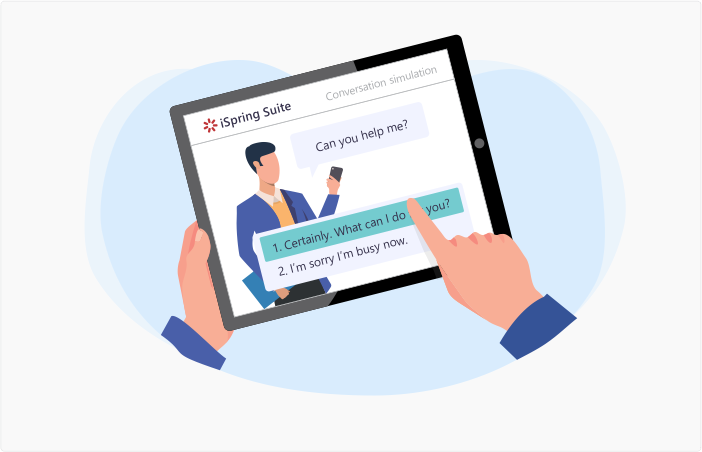
Overview: A conversation simulation is kind of an interactive game that people can play on their computers and mobile devices. It imitates a conversation between the agent and other characters, for instance a customer. Each dialogue step can be based on a real business case from your practical experience. Learners are required to face a challenge in real time: correctly present a product, assign a task to a subordinate, or calm down an angry customer. To see just how engaging and realistic conversation simulations can be, take a look at this dialogue simulation that trains car salesmen on how to deal with customers.
Time: 5+ minutes
Number of participants: One person
Tools needed: A computer or mobile device and an authoring tool to create the simulation, such as iSpring Suite.
Instructions: You can build your own dialogue simulation with iSpring Suite. Learn more at How to Create Conversation Simulations with iSpring →
Why play it: The goal of a simulation is to teach employees to speak clearly and concisely, addressing the point of the conversation as quickly as possible. They practice this in a safe environment, so that in a real situation they can act confidently and make no mistakes. Some other benefits of a dialogue simulation are that agents can complete them in their own time, so there’s no need to gather all the employees together for formal training. Everyone can train individually whenever and wherever they want. Plus, you can easily and objectively assess all your employees’ results.
2. Yes, and…

Time: 5+ minutes
Number of participants: Two or more people
Tools needed: None
Instructions: This story weaving exercise builds on the “Don’t deny” principle.
- One person starts with one sentence of a story.
- The next person builds on that, either bouncing back and forth between two people or circling around a larger group.
- You can take a story in any direction, as long as it builds on top of the previous sentence with a “yes, and…”
Why play it: This game teaches some crucial customer service skills, primarily listening skills. You have to build upon what was said last. A bad conversation habit is to be overly focused on what you want to say. While the other person is talking, many people miss out on a lot that’s been said. It also teaches flexibility. Instead of going against what’s been said, your aim is to build on top of it. Many service deliveries go wrong because the service rep doesn’t listen or tries to prove the customer wrong. Bottom line? It works better to build on what’s been said.
3. Customer Role Play

Time: 30 minutes
Number of participants: Four or more people
Tools needed: A pen and paper
Instructions: This improvisation game is tailored towards customer service.
- Divide the team into pairs, with group A playing angry customers and group B playing the service reps.
- The customers are either handed a certain complaint, or can think of one themselves (think ridiculous complaints, e.g. “the internet was too fast”). Also, they are given a goal, for example to get a full refund.
- The service reps in Group B are tasked with resolving the situation. They, too, have a goal – to calm down the customer and minimize the damage as much as possible. They might not be allowed to give a refund, for example, but are allowed to give away a voucher or a month of free service.
- The couples then perform their role play in front of the group. The performers are encouraged to be creative, especially the customers.
- After the role play, the rest of the group can give feedback, e.g., what the service rep could have done differently to minimize the damage.
Why play it: This is a useful exercise for both groups. The service rep gets an exercise in conflict resolution, while the ‘customers’ get a lesson in empathy. It’s also fun for the group to recognize typical arguments and dilemmas they encounter in everyday life.
4. The Customer is Always…
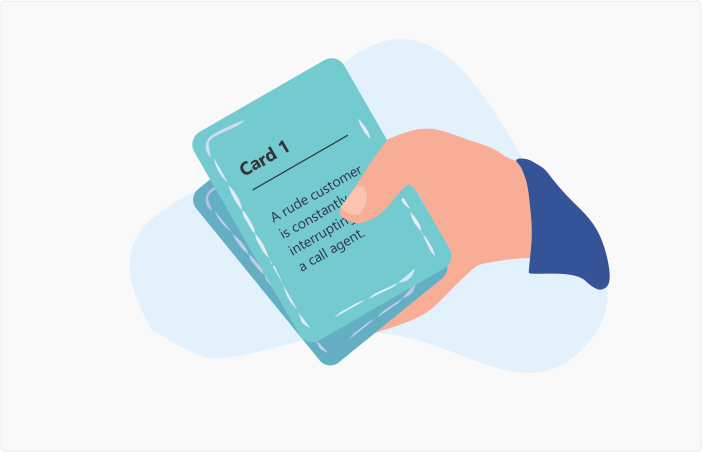
Time: 30 minutes
Number of participants: Two or more people
Tools needed: A pen and index cards
Instructions: This role play game uses index cards to simulate different types of problematic customers and situations.
- Write down several different problematic customer service scenarios (one per index card).
- On a separate set of cards, write down an equal number of problematic customer types (angers quickly, interrupts often, etc.).
- Choose an agent to go first. A second agent acts as the customer. They randomly select cards from their respective stacks and use the information to act out their roles.
- The challenge is to maintain a pleasant and professional tone while offering creative explanations to a repeatedly wrong customer.
- The remaining agents are the judges. They score each other on how well they resolve the customer’s problem, how well they maintain control of the conversation, and their success in saving the customer’s experience.
Why play it: To improve agents’ abilities to speak comfortably and naturally ‘off script’, and resolve uncomfortable situations without compromising customer service.
5. Never Say Never
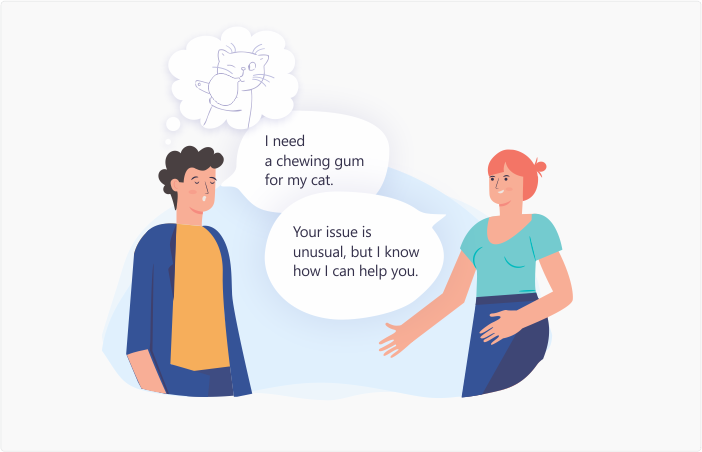
Time: 30 minutes
Number of participants: Two or more people
Tools needed: A pen and name tags
Instructions:
- Make sure that everyone has a clearly legible name tag, and then have your new employees gather in a large circle.
- Instruct each employee to think of two or three requests that they’d like. The requests can be reasonable or unrealistic.
- Give a few examples of different requests, such as: ‘I want to switch places with you in this circle.’ Or ‘I want a personal spacecraft’. Give the employees a few minutes to think up a couple of requests.
- Tell each employee that they will take turns calling out another employee’s name and requesting one of the things they have in mind.
- That named employee then has to deny the request, without actually saying ‘No.’
- That named employee will then name another employee, ask for a request that must be denied, and so on.
- Start with an example between yourself and another group leader, and then get the group started.
Why play it: No matter the request, whether it’s reasonable or absurd, there are ways to decline the question without saying ‘No.’ Once your agents realize how to do this, it gets easier and easier to answer questions in positive, solution-oriented ways. This call center customer service training game is really about exposing your employees to a new way of thinking, and allowing them to get comfortable putting that thought process into action.
6. Just a Minute

Time: 3 minutes per person
Number of participants: Two or more people
Tools needed: A stopwatch, a whistle to signal the end of one minute, a whiteboard to keep score. Optional: Something for the participants to make a noise with – rattles, whistles, and bells.
Instructions:
- Explain that the objective is to speak for one minute on a topic which you will give them, without deviation, hesitation or repetition of any word.
- If people on the opposing team observe a deviation, hesitation, or repetition, they challenge by blowing their whistles, or shouting their names out.
- You must stop the clock when a challenge takes place.
- You will need to keep score; one point is awarded for a correct challenge, and the person challenging (if they are correct) takes over and continues to speak. This continues until the minute is up.
- If the challenge is incorrect, you award a point to the speaker, and they are allowed to carry on.
- Provide subjects related to customer service, such as the customer is always right, dealing with angry customers, when something goes wrong, the customer’s shoes, going the extra mile, good customer service, etc.
Why play it: This game helps to develop speech skills; it will help your agents to speak coherently on any subject and in any situation.
7. Customer Service Bingo
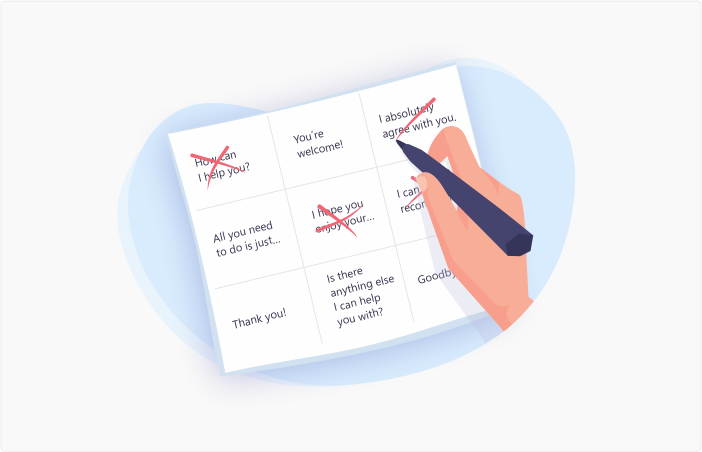
Time: 30 minutes
Number of participants: Five or more people
Tools needed: A pen and paper, bingo cards
Instructions:
- Create two bingo style cards; you should be able to easily find free templates online.
- Fill in one card with customer service phrases for your people to spot during role plays, or when listening to calls.
- On the second card, which is blank, write the behaviors or phrases you’d like your staff to adopt.
- Get them to evaluate their own calls, and give prizes to the people who shout ‘bingo’ when they are first to fill their card.
Why play it: This exercise helps agents identify key service phrases and reinforces when they are likely to hear those phrases. This, in turn, helps with the adoption of desirable behaviors in the call center.
8. The “Customer Experience” Game

Time: 30 minutes
Number of participants: Two or more people
Tools needed: A pen and paper
Instructions:
- Give each advisor a sheet with a list of things that add value to the customer experience, e.g. advising them of other recommended products or capturing contact details.
- Place tick boxes next to each item.
- Throughout the day, advisors can then tick the relevant boxes as and when they perform those actions on a call. The catch is that only one tick can be added per customer, so advisors can’t fill in their whole card on the first call of the day.
- When they have ticked off the entire list, they can exchange their sheet for a raffle ticket (and get a new sheet).
- The tickets are then entered into a drawing at the end of the day/week/month.
Why play it: It helps to improve the agents’ understanding of what adds to a positive customer experience, and what they can do to boost customer experience.
Call Center Motivational Games
Keeping call center staff motivated can be tough. Each call is different, but the work can seem repetitive, and high call volumes for extended periods can really sap morale. This set of call center motivational games can help you re-energize your agents.
9. Monopoly
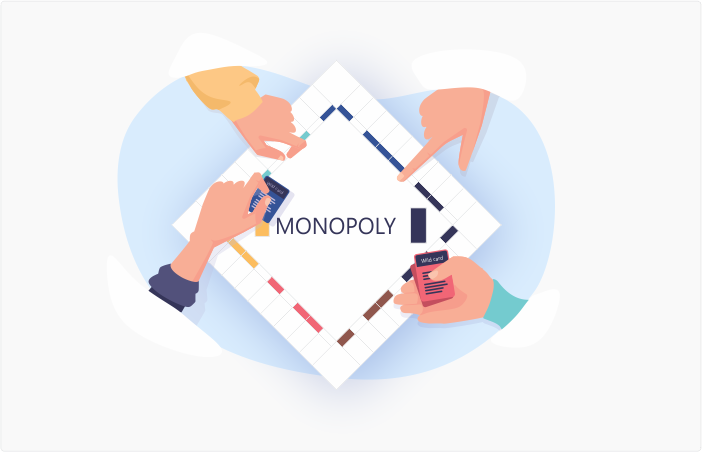
Time: 30 minutes
Number of participants: Two or more people
Tools needed: A pen and paper, a dice
Instructions:
- Recreate the board by using names relevant to your business, yet keeping the normal squares, like ‘Go To Jail’, ‘Community Chest’, etc.
- Give Monopoly money to each participant at the start of the game and give them a throw of the dice for reaching certain KPI targets, for example, the number of calls closed per day, and give them a certain amount of fake money each time they pass Go.
- Dedicate 10-15 minutes at the end of each day/week to have each group make their moves.
- If team A has 5 throws to use but team B only has 3, use the order A-B-A-B-A-B-A-A
- The goal is to hoard the Monopoly money rather than spend it on houses/hotels.
- After 2-3 months, allow the players to use their Monopoly money on prizes, like extended lunch breaks, mini toys, and any other cool stuff you think your team might like.
Why play it: This game is great because it keeps things interesting, and gets your agents interacting with each other. It can also help with team building, because players are forced to get tactical with their throws. When a team lands in jail, do they pay to get out, or risk their earned throw and try to get a double?
10. Who’s the Celebrity?

Time: 2 hours
Number of participants: Two or more people
Tools needed: A printer, post-it notes
Instructions:
- Print out an image of a celebrity, pin it to a wall or noticeboard in full view of your team, and cover it up with a grid of post-it notes.
- Each time an agent makes a sale or meets some other criterion (such as earning great customer feedback), they get to remove a post-it from the board. Whoever identifies the celebrity on their turn will be given the prize!
- Print out a few pictures to keep the game going throughout the day. You can offer clues too, and vary celebrities by industry, age, etc.
Why play it: This is one of the simplest call center games for customer service to set up, but encourages agents to hit their targets quickly.
11. Mystery Prize

Time: 1 to 3 Days
Number of participants: Two or more people
Tools needed: None
Instructions: Put a little intrigue into your workplace with Mystery Prize call center contest ideas.
- Choose an unusual mystery prize that your team members won’t easily guess. Then, hide the prize or a picture of the prize somewhere in your call center.
- Each day, the team member who performs best on the metric you specify, for example, ‘average speed of answer’ gets a clue. Clues can be about what the mystery prize is or where it’s located. The more clues they get, the closer they get to finding the prize. The first person to identify it wins it!
Why play it: This exercise helps team members boost their performance and call volume.
12. Call Center Olympics
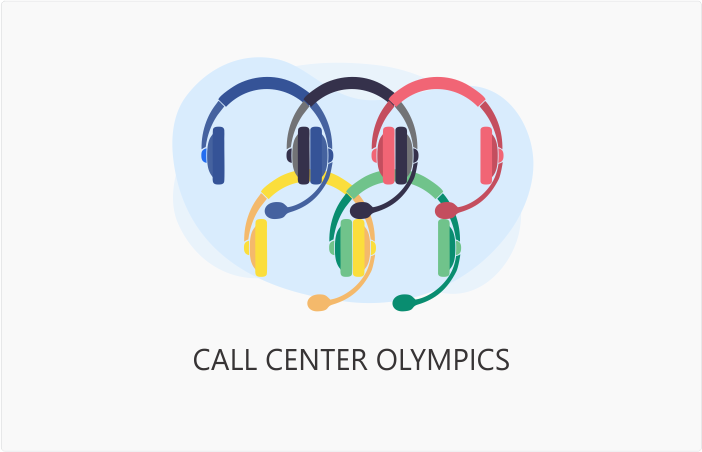
Time: 30 minutes
Number of participants: Two or more people
Tools needed: A pen and paper
Instructions:
- Choose several metrics, for example, ‘average handle time’ and ‘first call resolution’ to compete in and set the time period for the games.
- Each KPI is considered a sport. The person who has the best KPI score for that sport gets a medal or ribbon for the win.
- To wrap up your Call Center Olympics, you can have a party to celebrate the winner’s success. Create an awards ceremony to honor the top three winners.
Goal: If your team is lagging and you want to really boost all your metrics, try Call Center Olympics.
13. Jenga

Time: 30 minutes
Number of participants: Two or more people
Tools needed: Jenga set
Instructions:
- Set up the stack, and whenever a team member completes a successful outcome, for example, closing 10 calls, they can pull out a piece. If they put it back on the top of the stack successfully, they get a point.
- Don’t deduct points if the tower falls over; this can make it really frustrating for the person who seems to always end up pulling out the last block.
- It’s up to you what you do with the points system. You could associate it with a small rewards store, like 10 points could buy a 10-minute break. Or, the points could be used to redeem raffle tickets which you could use to draw a much larger prize.
Goal: Jenga is a fun way to motivate employees to perform. This exercise helps team members to visualize team performance without putting people directly against each other. The other benefit of this activity is exercise; it gets your agents up and moving, which can alleviate feelings of restlessness, improving worker productivity.
Call Center Problem-Solving Games
Call center agents aren’t robots, and while much of the job may revolve around scripts, there’s no downside to improving your team’s problem solving abilities. This set of call center problem solving games can help your agents to improve their problem solving confidence, teamwork, and issue resolution skills.
14. Use What You Have

Time: 30 minutes
Number of participants: Four or more people
Tools needed: A pen and paper, various supplies (per-game basis)
Instructions:
- Divide your team into equal groups. Create a specific project with clear restrictions and a goal. For example, you might have your team create a device that involves movement without power, and moves a marble from point A to point B. The challenge is completely up to you.
- Give each team the same supplies to work from, or create a pile of available supplies in the middle of the room.
- Give them a specific time to complete the project, making sure to mention that they can only use what is available, though how they use it is completely up to them.
- The final reveal is a fun event, and a great opportunity for your team to compete.
Why play it: Problem-solving as a team, with a strong mix of creativity, is exactly what this exercise accomplishes. It also brings an element of fun and maker-ism into the mix, with the added twist of learning how to solve a problem with reduced options.
15. Escape Room
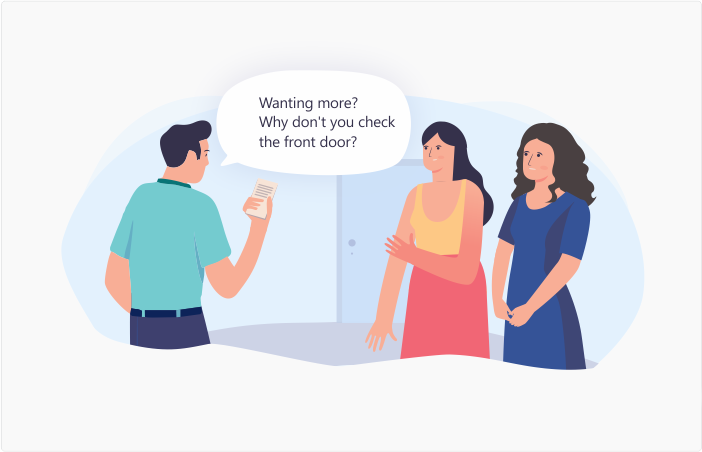
Time: 30 minutes
Number of participants: Two or more people
Tools needed: A pen and paper
Instructions: The idea is to gather your team in a room at a designated location and lock them inside. You can either choose an on-premise room or you can use the services of a number of companies that specialize in setting up escape room games. The end goal is for your team to escape the locked room within a specified period of time.
- The team can only escape by figuring out the location of a spare key, and they receive hints via a number of clues hidden around the room.
- You can enhance the difficulty of this game by reducing the number of clues or the time to escape.
Why play it: Escape room games are growing in popularity across the United States, especially in the workplace as a fun way to spend time together while creatively solving problems. Despite its role as a leisure activity, setting up an escape room at work is one of the best team-building, problem-solving activities you can create for your employees
16. 6-8-5
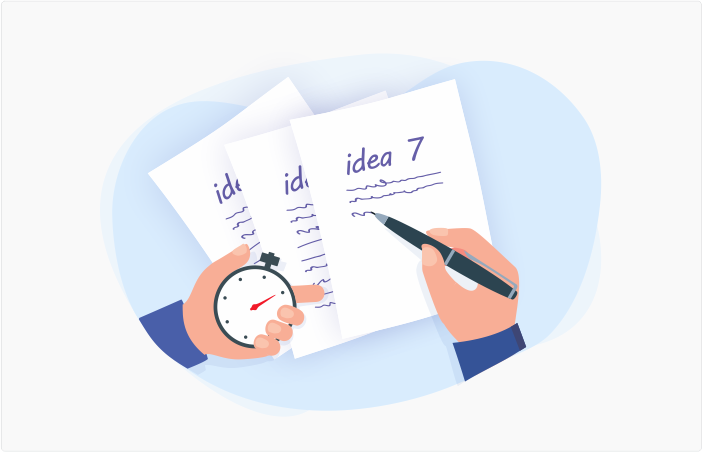
Time: 1 to 30 minutes
Number of participants: Two or more people
Tools needed: A pen and paper
Instructions:
- Before the meeting, prepare several sheets of paper with a 2×2 or 2×3 grid.
- Select a theme for the game. The ideas that your team will generate should be based on the theme, for example, ‘How can we retain more customers?’
- Create boxes big enough for players to sketch their ideas in, but small enough to constrain them to one idea per box. Prepare enough paper for everyone to have about 10 boxes per round.
- Distribute sheets of paper to each player, or instruct the group on how to make their own 2×2 grid by drawing lines in their notebook.
- Introduce the game and remind the players of the objective of the meeting. Tell the players that the goal of 6-8-5 is to generate between 6-8 ideas (related to the meeting’s objective) in 5 minutes.
- Set a timer for 5 minutes.
- Tell the players to sit silently and sketch out as many ideas as they can until the timer ends, with the goal of reaching 6-8 ideas. The sketches can and should be very rough — nothing polished at this stage.
- When the time runs out, the players should share their sketches with the rest of the group. The group can ask questions of each player, but this is not a time for a larger brainstorming session. Make sure every player presents their sketches.
- With time permitting, repeat another few rounds of 6-8-5.
Why play it: Rarely are ideas born overnight. For an idea to become a great idea, it takes considerable work and effort to develop. Part of the reason we end up with under-developed ideas is that we stick with the first good idea we have, rather than taking the time to explore complementary approaches. 6-8-5 is designed to combat this pattern by forcing us to generate lots of ideas in a short period of time. The activity can then be repeated to hone the best ideas.
17. Great Egg Drop

Time: 30 minutes
Number of participants: Six or more people
Tools needed: Eggs, masking tape, straws
Instructions:
- Split your team up into smaller groups of three or four members and give them an egg, masking tape, and some straws.
- The goal for each group is to build a structure that protects the egg from a drop of some designated height.
- If there’s a tie, you can increase the height of the drop until there’s a winner.
Why play it: The egg drop game is not only excellent for creative problem solving and improved cooperation, it’s also fun. Just make sure you set the game up in a place that’s easy to clean.
Call Center Team Building Games
Who doesn’t want a strong team with a sense of collective responsibility and pride? A well-bonded team takes care of each other and is more motivated. A lot of the call center games we’ve covered already focus more on developing individual skills and motivation. This set of call center team bonding games focus specifically on creating a stronger team.
18. Scavenger Hunt
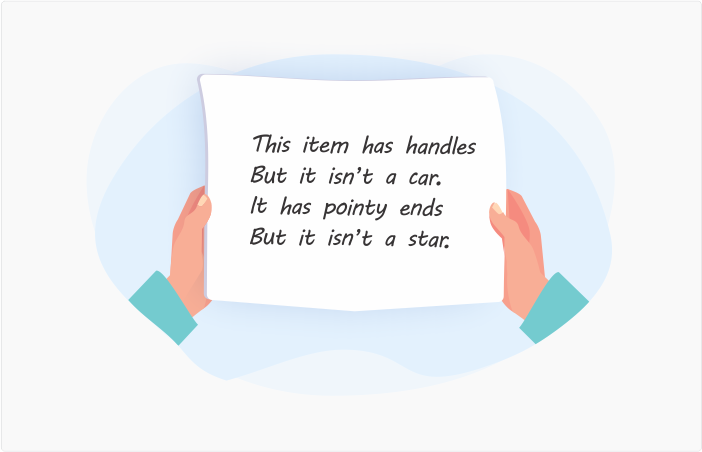
Time: 30 minutes
Number of participants: Four or more people
Tools needed: Some items for the team to collect
Instructions:
- Divide your team into equal sized groups, and send them out with a list of items to locate and bring back. Whether they remain in the office or leave the building is up to you.
- The goal is to get back first with the most items. You may want to set a time limit so that all groups are back in a reasonable time, whether they find all items or not.
- A scavenger hunt can be themed, and might involve a variety of clues or other twists that force a team to get creative and work together.
- One variation is to make it a digital scavenger hunt in which they must find examples and specific information or web pages online. You may wish to restrict which search engines or methods they use to complete the challenge.
Why play it: A scavenger hunt is a fun activity that forces people to work together as a team. It spurs creativity, particularly if clues or puzzles are involved.
19. GPS Adventure
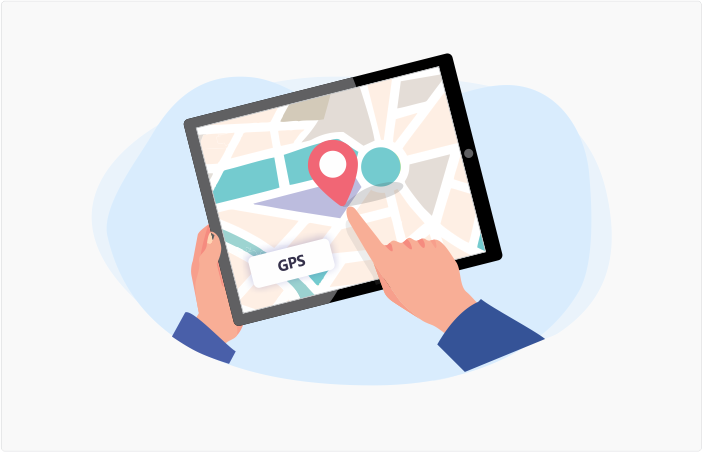
Time: 30 minutes
Number of participants: Two or more people
Tools needed: A GPS device for each team
Instructions: The GPS Adventure game relies on following clues to find a hidden item with the help of GPS coordinates. Each group of teammates needs to have a GPS device that will help in searches.
- A moderator sets a period of time in which all participating groups must return to ‘base’.
- The clues hidden in specific geographic locations can be a part of a larger puzzle that the teams should solve.
- As an alternative to GPS coordinates, you can also use QR codes placed around the office or neighborhood.
Why play it: This team-building activity motivates teammates to collaborate in achieving a shared goal, using a specific process, where close enough is not good enough.
20. Building the Team Bus

Time: 10 minutes
Number of participants: Four or more people
Tools needed: A pen and paper
Instructions:
- Split your team into groups and invite them to draw an outline of a bus on a sheet of paper.
- Within a set period (10, 20, or 30 minutes) they should start to add different touches to the bus and explain how they can promote good teamwork.
- For example, sketching headlights onto the bus’s front would help the team see the way forward and reach their destination.
- Adding mirrors would enable the agents to look back at what they’ve learned and experienced, to help them get ahead more efficiently.
- Give the team with the most helpful additions the prize.
Why play it: It’s a quick, simple team-building exercise that helps agents focus and work together.
21. Human Knot

Time: 15 to 30 minutes
Number of participants: 8 to 20 people
Tools needed: None
Instructions:
- Instruct the participants to stand in a circle, shoulder to shoulder.
- Tell everyone to put their right hand in the air and grab the hand of someone standing across the circle from them.
- Now tell everyone to put their left hand in the air and grab the hand of a different person.
- Someone needs to check that everyone is holding the hands of two different people and that no one is holding the hand of someone who’s standing directly next to them.
- The objective of the game is to untangle everyone without breaking the circle.
- If the chain is broken, participants will have to start over.
Why play it: This brain teaser is funny and really works on teambuilding, problem solving and communication. This exercise will prove to be extremely challenging and will rely heavily on teamwork and communication.
Have you integrated any call center games for customer service, motivation or team building into your call center’s everyday processes? If so, what results or improvements have you achieved? Please tell us in the article comments; we would love to know!




